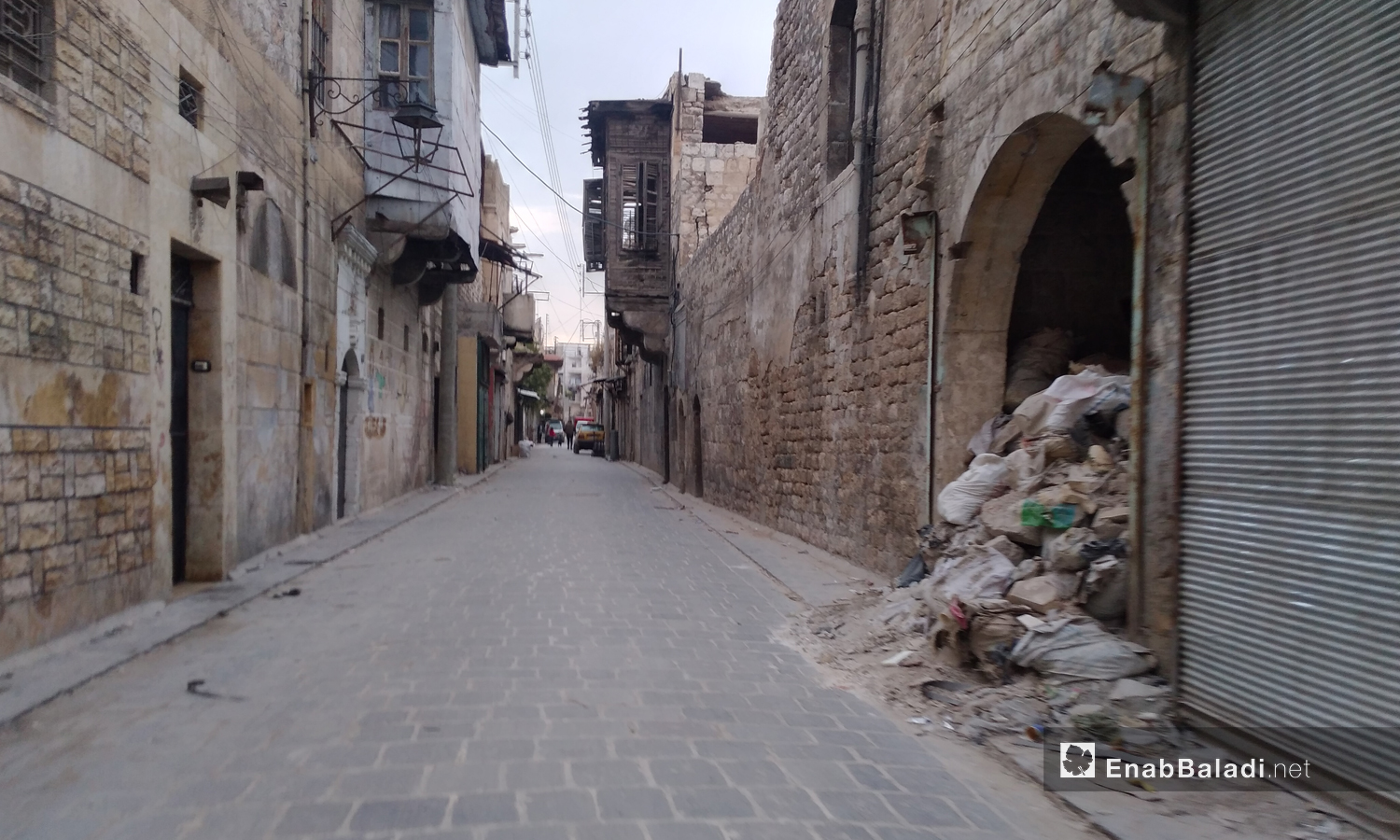



Enab Baladi – Aleppo
Mustafa has lived for over 30 years in a building located in the al-Ferdous neighborhood in Aleppo city. He, however, feels the need to evacuate every time there are heavyheavy rains.
Draining rainwater has become a habit for the residents of cracked buildings, that are affected by the bombing throughout the war. Rainwater seeps into basements, threatening the buildings’ structural safety and their foundations. Nevertheless, drawing rainwater away, which cost amounts to 15,000 Syrian pounds (SYP = 5 USD), after each rainfall is neither a safe nor a practical solution to prevent the buildings’ collapse.
As they fill with water after every rainfall, basements have become a source of threat to residents in the neighborhoods of al-Ferdous, al-Saliheen, and al-Nayrab, who filed complaints and requested the help of municipalities, which in turn, did nothing other than offering them empty promises.
Mustafa and his neighbors fear the collapse of the building they have emptied from rainwater many times.
“The building foundations are dilapidated. The building may collapse at any time now. Some residential buildings have collapsed over the past two years as a result of rainwater leak,” Mustafa told Enab Baladi, requesting that his surname be withheld.
Many residential buildings in Aleppo city, especially in the eastern districts, have fallen after they were bombed during the armed opposition control.
In March 2018, an apartment building in the al-Safa neighborhood collapsed, killing three people. Several similar incidents followed in 2019. On 6 January, a five-story building collapsed in the al-Saliheen neighborhood, killing a man and his wife and injuring their two children. In February of the same year, a building collapsed in the Salaheddine neighborhood leaving 11 people dead.
In December 2019, 12 civilians were killed due to the collapse of a building in the al-Maadi neighborhood in Aleppo city, while other buildings fell without causing casualties. In August 2020, a four-story building collapsed in the al-Saliheen neighborhood, killing a woman and wounding another person.
Four years after the Syrian regime regained control over Aleppo city in December 2016, it did not fulfill its promises of restoration and rehabilitation to prevent the collapse of dilapidated buildings. The regime’s officials tried to evade their responsibility by claiming that the collapsed buildings had no cracks to evacuate them.
Some families are forced to evacuate their houses until water is drained from their buildings’ basements. The rainwater is drawn by using power generators, and when heavy rainfalls cause flooding, the residents repeat the process all over again. These solutions, however, are temporary and insufficient to end the problem.
The second increase in cement prices has pushed the residents to undertake simple repair works to their buildings, which they could not afford to rehabilitate completely.
Faisal, a resident of the al-Kalasah neighborhood in Aleppo, decided to share the cost of the basement’s temporary repairs with the rest of the building’s inhabitants. Even though the municipality is responsible for the full maintenance and rehabilitation works to the cracked buildings, the residents do not expect it to bear the responsibility.
The residents bought five bags of cement, aggregate, and steel bars, to support the basement structure and block the leaking water. “This is a temporary emergency solution to prevent the collapse of the building and another disaster from happening,” Faisal, who preferred not to mention his full name for security reasons, told Enab Baladi.
Other people in the area try to fix the basements’ leaking sources with cement while looking for locations where rainwater leaks downward.
Despite the fact that many civilians have carried out renovation and maintenance works to their basements, a contractor, who asked to remain anonymous, told Enab Baladi that these repairs are useless.
“Flooded basements’ restoration cost has become very high. Special professional committees must assess the possibility of repairing the damages after inspecting the basements’ building structure. The residents should not have to come up with immediate and random restoration solutions to prevent the collapse of dilapidated buildings over their heads,” the contractor said.
Before the building process, a civil engineer sets out a detailed blueprint, including construction drawings for the basement’s foundations. “The foundations are the basis of any building project,” the contractor said, explaining that residential buildings’ foundations, set at a depth of half a meter in the ground, must be solid. The foundations transfer the building’s weight to the ground, and when the building includes a basement, the foundations of the building are based on the basement to ensure stronger consolidation of the building’s structure.
Water leaks or floods cause damage to the foundations. Aleppo’s eastern neighborhoods’ bombardment and the use of Russian concussion missiles have further weakened and cracked most of the residential buildings’ foundations, the contractor said. Those buildings would not withstand earthquakes or cracks by relying on temporary solutions, as their interior structure would break down.
The Committee of Public Safety, affiliated with Aleppo City Council, has assessed the damaged residential buildings to be demolished; however, it has not completed its work. The damaged buildings remain in place, particularly in the eastern neighborhoods of Aleppo.
In February 2019, Aleppo Provincial Council decided to evacuate more than 4,000 families living in 10,000 residential buildings. These buildings were dilapidated and at risk of falling. The assessment of the Public Safety Committee covered about 36 neighborhoods and mentioned that a total of 33,633 story buildings were intact.
According to official figures by the regime’s government, the damage level in eastern Aleppo has affected 70 percent of the buildings. Other government reports estimated that 30 percent of buildings are severely damaged and require rehabilitation before becoming habitable.
if you think the article contain wrong information or you have additional details Send Correction